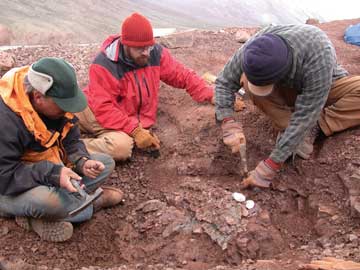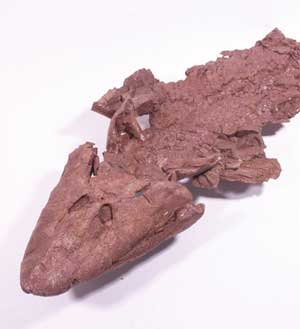|
Feature
PALEONTOLOGY: MISSING LINKS
Finding a Fishy Connection: Q&A with Jenny Clack
Plus! The top paleontology news stories of 2006
 |
| A team of researchers (above) in 2004 worked to unearth a new species, Tiktaalik roseae (below). Work was published this year about the species, somewhere between fish with fins and tetrapods with feet, which filled a gap in the fossil record between water and land animals.Photographs courtesy of Ted Daeschler. |
 |
In 2006, paleontologists unearthed a plethora of fossils that filled in some of the gaps in species’ evolutionary records. One particular find, however, discovered in 2004 and described this year in two April 6 Nature papers, “wiped everything else off the map,” says Jenny Clack, a paleontologist at the University of Cambridge.
Clack spoke to Geotimes reporter Kathryn Hansen about Ted Daeschler’s and colleagues’ discovery of a 375-million-year-old complete specimen of Tiktaalik roseae in the Canadian Arctic. The creature’s ambiguous morphology, including fin-like appendages that show signs of developing an internal skeletal support structure, places it as a transitional species between fish with fins and tetrapods with legs (see Geotimes, June 2006). According to Clack, the find adds to the picture of early life and evolution on Earth.
KH: How was the discovery important to the field of paleontology?
JC: It was a big deal in the sense that it confirmed our suspicions and corroborated what we put together from other pieces. In this particular case, the fossil was virtually complete. There are still things we don’t know, but what was there was so beautifully preserved that it answered a great number of questions that hadn’t been answered previously.
KH: Is it rare to find such a complete specimen?
JC: Yes, it’s unusual. In the story of the origin of tetrapods, we now have some information on quite a number of different forms from around the world. But for quite a lot of them, we only have fragments, like lower jaws for example, and we’ve had to piece together the story based on that. But this particular specimen was also preserved in 3-D. The head was attached to the body, which allowed us to see things more clearly that we had only suspected before, and also answered some questions about the order in which some of the changes took place.
KH: What is the story that you’re trying to piece together?
JC: You’ve actually got a number of intermingled stories. The move from water to land is the most obvious, and people tend to imagine that it’s the same as the fin-to-limb transition, when in actual fact it isn’t quite the same thing — they’re disconnected. The evolution of air breathing is the third strand of the story, which again is separate. They’re all intertwined, but separate, strands of the same story.
KH: Did one change lead to another?
JC: Yes, there’s beginning to be a consensus on that. Primary reliance on air breathing was the first thing to happen. And that stimulated the evolution of supportive limbs, so that the head could be raised out of the water to breathe the air. And that led to use of the limbs then for walking. One of the things that Tiktaalik showed us was that some of the crucial changes occurred while the things were still technically fish, in the sense of having fins.
KH: Where do you draw that line between fish and tetrapods?
JC: It used to be easy 25 years ago, when I first started: Tetrapods had legs, and fish had fins. Now, it’s hard to distinguish fins from limbs, and that’s not the only crucial difference between the two.
In most fish, you have a series of bones at the back of the head. It covers the gill cavity and helps the pump that draws water through the mouth and out through the gill cavity. By flapping, it controls the exit of water. That series of bones becomes lost in tetrapods because they no longer rely on gill breathing to the same extent. And now we know that Tiktaalik had already lost that series of bones while it was still in the water. It started to rely on air breathing first, before it left the water.
KH: Can anything be said about why these changes happened?
JC: Some new estimates show the level of oxygen in the atmosphere, at the very time when these changes were taking place. For some reason, oxygen levels crashed at about 380 million years ago. This is the very time when we see first evidence of the lineage leading to tetrapods, and we also see that they are developing air-breathing modifications.
KH: So there might have been less oxygen in the water?
JC: There was less oxygen in the atmosphere, and that means there was even less in the water. And added to that, you get a great increase in the amount of cloud cover on the land. The plants then decay, leaves fall into the water, and that causes reduction in the oxygen as the bacteria break these organic remains down.
KH: Has Tiktaalik brought about any new questions?
JC: Well, yes, one very large question that wasn’t answered by this animal, is when did the hind limbs and the pelvic girdle really become larger? The one big difference between fish and tetrapods is the size of the hind limbs, and how the hind limbs attach. Fish hind fins are really small and weedy, very insignificant in terms of size, whereas the first tetrapods we know of have quite massive hind legs and big pelvic girdles. But the gap between the two still exists. We don’t know where, when, how or why the hind limbs increased in size.
KH: What type of hind limbs did Tiktaalik have?
JC: We don’t know, we don’t have [this part of the fossil yet]. But we suspect that they were quite small. Otherwise we probably would have found them.
KH: How did the team find Tiktaalik?
JC: One of the exciting things was that the [research team] predicted that [the Canadian Arctic] would be a good area because it had the right aged rocks, the right types of sediments, and so they targeted it specifically for this kind of material. It took them several years to actually find it, but it was the result of an educated guess about where to go.
KH: Is that a different way to approach this kind of research?
JC: Yes, quite often major finds are made by relative serendipity. You find a fragment in a museum drawer and you suddenly recognize it for what it is, and then you go to where it was found and you find more of it. But they had no real previous vertebrate specimens from [the site]; they just had the geological evidence of the sediments and they said, “that’s where we’re going,” so they went there and they found it.
KH: What’s next in this line of research?
JC: The team [returned to the site] this summer. What they wanted to do was find the back end of Tiktaalik, but unfortunately, I hear on the grapevine that they just found more front ends.
What I would personally like to do is to get to know what happened next. We’ve got quite a number of different sorts of animals now representing the late Devonian, and the first creatures with legs. I want to know what happened after the end of the Devonian [from about 385 million to 359 million years ago], in the next period, which is the Carboniferous. This is the big goal, the next ambition.
Links:
"Fish fossil fills evolutionary gap," Geotimes, June 2006

 Subscribe
Subscribe

